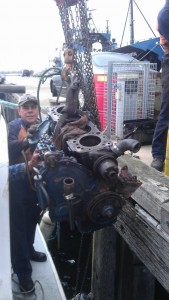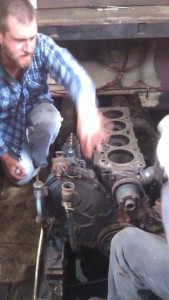Tom’s building a steam truck!
by steamtug on Oct.17, 2012, under General
 His truck has been under construction for a few years now, but ’tis getting to the pointy end of the project, and I helped him get the boiler certified so now it’s up and running. As a pay back, Tom helped me get the engine out of poor Adaqua, still stranded in Williamstown which is 5 hours by sea from her home port! Hopefully coming home soon, minus the blown up engine… read on!!!
His truck has been under construction for a few years now, but ’tis getting to the pointy end of the project, and I helped him get the boiler certified so now it’s up and running. As a pay back, Tom helped me get the engine out of poor Adaqua, still stranded in Williamstown which is 5 hours by sea from her home port! Hopefully coming home soon, minus the blown up engine… read on!!!
You may recall seeing the truck in the shed during the “world’s greatest train set” episode of this blog. I have not had anything to do with this, but basically he has sourced some bits and bobs, chucked them all together over the past few years, slung the engine that fed the coal into an old steam locomotive underneath and built some pretty neat chain drives, and an intricate Hackworth valve gear to time the steam in and out of the engine for forward and backwards, and he was last seen disappearing down the road in a cloud of steam!
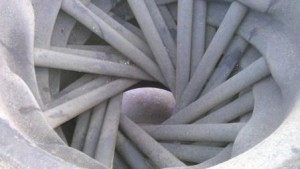 It’s loosely based on a Sentinel steam wagon from Yorkshire in merry old England. The boiler is an original Sentinel forged steel shell that was abandoned, and rusted out. But using modern technology has been repaired using 10,000 welding rods… (Or maybe 20!) So I laugh at his boiler made of weld and we were kind of skeptical
It’s loosely based on a Sentinel steam wagon from Yorkshire in merry old England. The boiler is an original Sentinel forged steel shell that was abandoned, and rusted out. But using modern technology has been repaired using 10,000 welding rods… (Or maybe 20!) So I laugh at his boiler made of weld and we were kind of skeptical 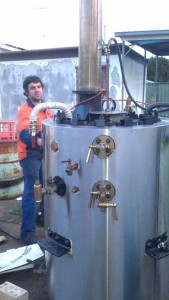 at the testing we had to undergo in order to gain certification so it could be used. This was an enormous expense, but building a new boiler would not be possible as the dye’s required to roll the shape inside for the tubes no longer exist. And these boilers have the extraordinary ability to produce more steam that anyone could imagine in such a small space. Rated at 80 horsepower, I know other boilers that fill a whole shed in order to perform the same. Granted, the efficiency is totally out the window as the little vertical boiler is forced so hard, but then carrying around an efficient boiler that fills a shed is not viable in a truck either.
at the testing we had to undergo in order to gain certification so it could be used. This was an enormous expense, but building a new boiler would not be possible as the dye’s required to roll the shape inside for the tubes no longer exist. And these boilers have the extraordinary ability to produce more steam that anyone could imagine in such a small space. Rated at 80 horsepower, I know other boilers that fill a whole shed in order to perform the same. Granted, the efficiency is totally out the window as the little vertical boiler is forced so hard, but then carrying around an efficient boiler that fills a shed is not viable in a truck either.
Some of this in-efficiency is recovered by fitting a huge superheater in the boiler top which adds another large amount of energy to the steam produced making use of the wasted heat. And if you thought a steam engine was a “pressure” engine instead of really being a “heat” engine, then get this… A chap we know developed a leak in his superheater while out on the road. His plan to get home again, was simply to by-pass the superheater and run the engine on saturated steam. Well it didn’t work, as they could not keep the water up to the boiler fast enough due to the huge increase in steam volume required to run with superheat. So that proves it!
As you can see from the photos, the boiler has a unique pattern of stacked water tubes that swirl the flue gases up absorbing the heat from the fire in a very short space, while the rapid movement of water on the inside of the boiler ensures quick steam raising capacity with only a couple of buckets of water in the whole damn thing! Very clever those old pommy chaps! And the boiler is made in 2 halves that bolt together, one inside the other making it easy to pull apart for inspection.
Scientific engineering calculus…
But when we bolted it up and did the hydrotest, it refused to stop dripping! So as the certifying engineer on this project, I could not pass it like this. So we decided to calculate just how much we were loosing. So by a sophisticated engineering calculus, we devised a procedure. Firstly we noted how much pressure had been lost over the hour. Next, we established how many pumps on the bucket pump was needed to restore the pressure to the original. Next, we disconnected the pump and found a suitable measuring container. Well the nearest thing was one of the empty stubbies we had consumed earlier, so this was employed as our calibrated scientific measuring device. Now volume that was pumped was repeated into this receptical and our conclusion? “She uses 1 1/2 stubbies per hour!” So… that will do me fine. When I am fireman, I expect an allowance of 1 1/2 stubbies every hour to keep the boiler on line. Fair enough eh?
The next problem… how to seal up the leaks. We tried getting her hot. But as the officiating engineer, I had to ensure it was done safely because this is currently and unregistered, and untested boiler with all the safety devices removed and blanked off for the hydrotest. So we wired the main steam outlet valve fully open so it could not be closed and pressured up. We fired up the oil burner for the first time which was quite exciting and it didn’t take long for a plume of roaring steam to reach for the sky. I came back the next day and it had improved some, with the heating and cooling helping to settle all the flanges together. But still not enough to pass.
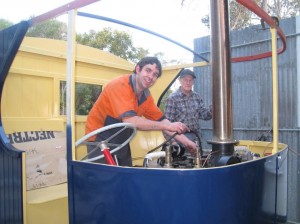 Next came the trick used by the old bush boiler men. Uncle Toby’s oats! A whole packet was emptied into the boiler and we steamed her up again! The smell was increadable, but the next time we tested, all those tiny cracks had been gummed up so well, that she was tight and passed her hydrotest and certificate of registration was issued and away we go! So if you are at the steam rally and see Tom’s truck, ask him if that’s the Uncle Toby’s cooker made of weld, that needs 1 1/2 stubbies per hour to keep her going! It’s sure to get a laugh!!!
Next came the trick used by the old bush boiler men. Uncle Toby’s oats! A whole packet was emptied into the boiler and we steamed her up again! The smell was increadable, but the next time we tested, all those tiny cracks had been gummed up so well, that she was tight and passed her hydrotest and certificate of registration was issued and away we go! So if you are at the steam rally and see Tom’s truck, ask him if that’s the Uncle Toby’s cooker made of weld, that needs 1 1/2 stubbies per hour to keep her going! It’s sure to get a laugh!!!
Adaqua… the saga continues
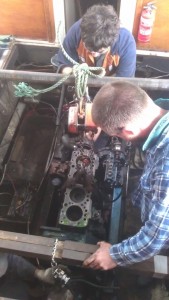

So as a pay back for my involvement Tom is working like a man possessed to get Adaqua home and ready for the parties of summer by making use of the great pier we were tied up to, and get the engine out. By the time I got down there, Jamie and Tom had stripped the poor engine of everything! No manifolds, cylinder head, starter, alternator, fuel system etc… all gone. Next a work mate of Tom’s rolled up with chain blocks, steel poles and blocks. As Benny Hill once said “They called him Ernie, and was the fastest rigger in the west! Tom and Ernie work close by, so having the boat in Melbourne was proving an advantage. Ernie was a little chap, but like a fox terrier on meth-amphetamines! He wizzed around and had the engine hanging in Adaqua’s doorway from the Hiab crane on the truck out of the pier in no time. We then took the engine down to the workshop, pulled off the sump pan and cringed at the sight of number 2 big end bearing. Oh, dear… total rebuild needs to follow this. Bugger… it’s not the battery terminals!
